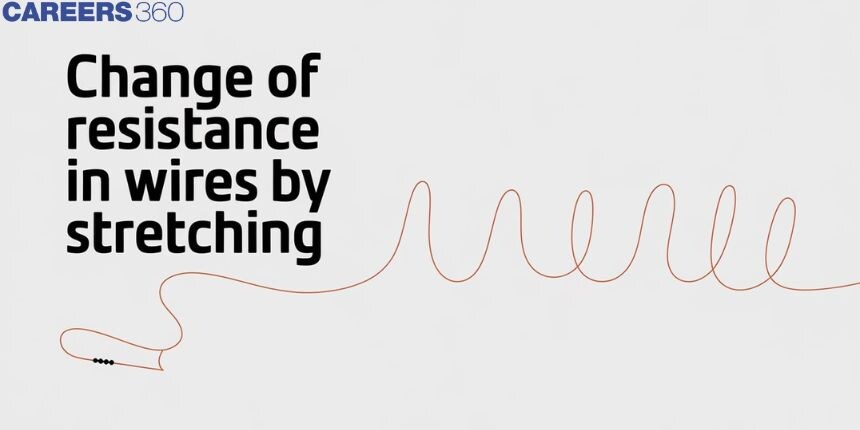Change Of Resistance In Wires By Stretching
The resistance of a wire changes when it is stretched, a phenomenon that is directly related to the wire's physical dimensions and the material's properties. As a wire is stretched, its length increases and its cross-sectional area decreases, leading to an increase in resistance. This concept is important in various applications, such as in strain gauges, where the change in resistance due to stretching is used to measure mechanical strain. In everyday life, understanding how stretching affects resistance can help in designing and maintaining electrical systems, ensuring that wires function safely and efficiently under different mechanical stresses. This article discusses the principles behind the change in resistance due to stretching, the mathematical relationship governing this change, and some solved examples based on this concept.
New: JEE Main/NEET 2027 - Physics Important Formulas for Class 10
JEE Main 2025: Study Materials | High Scoring Topics | Preparation Guide
JEE Main 2025: Syllabus | Sample Papers | Mock Tests | PYQs | Study Plan 100 Days
NEET 2025: Syllabus | High Scoring Topics | PYQs | Crack NEET in 2 months - Study Plan
- Stretching of wire
- Solved Examples Based on Change Of Resistance In Wires By Stretching
- Summary

Stretching of wire
If a conducting wire stretches its length increases area of cross-section decreases but the volume remains constant

Suppose for a conducting wire before stretching
it's length $=l_1$, area of cross-section $=A_{1, \text { radius }}=r_1$, diameter $=d_1$, and resistance $R_1=\rho \frac{l_1}{A_1}$
After stretching length $=l_2$, area of cross-section $=A_{2, \text { radius }}=r_2$, diameter $=d_2$
$
\begin{aligned}
& \text { and resistance } R_2=\rho \frac{l_2}{A_2} \\
& \qquad \frac{R_1}{R_2}=\frac{l_1}{l_2} * \frac{A_2}{A_1}
\end{aligned}
$
But Volume is constant So
$\begin{aligned} & A_1 l_1=A_2 l_2 \\ & \Rightarrow \frac{l_1}{l_2}=\frac{A_1}{A_2} \\ & \text { Now } \\ & \frac{R_1}{R_2}=\frac{l_1}{l_2} * \frac{A_2}{A_1}=\left(\frac{l_1}{l_2}\right)^2=\left(\frac{A_2}{A_1}\right)^2=\left(\frac{r_2}{r_1}\right)^4=\left(\frac{d_2}{d_1}\right)^4\end{aligned}$
If a wire of resistance $R$ and length I is stretched to length nl, then the new resistance of a wire is $n^2 R$
Recommended Topic Video
Solved Examples Based on Change Of Resistance In Wires By Stretching
Example 1: If a wire is stretched to make it 0.1% longer, its resistance will
1) increase by $0.05 \%$
2) increase by $0.2 \%$
3) decrease by $0.2 \%$
4) decrease by $0.05 \%$
Solution:
Ratio of resistances
If length is given
$R \alpha l^2$
wherein
$
\begin{aligned}
& \frac{R_1}{R_2}=\left(\frac{l_1}{l_2}\right)^2 \\
& \quad l A=\text { constant } \\
& A=\frac{K}{l} \\
& R=\frac{\rho l}{A}=\rho \frac{l}{K / l}=\frac{\rho}{K} l^2 \\
& \quad l=l_0+(0.001 l) \\
& R^{\prime}=\frac{\rho}{K} l_0^2[1+0.001]^2=R_0[1+0.002]
\end{aligned}
$
Hence, the answer is option (3).
Example 2: A copper wire is stretched to make it 0.5 % longer. The percentage change (in %) in its electrical resistance if its volume remains unchanged is :
1) 1
2) 2.5
3) 2
4) 0.5
Solution:
Stretching of wire
If a conducting wire stretches its length increases area of cross-section decreases but the volume remains constant
Since Volume is constant
Let the initial area of the wire be A, the length be L and the resistance be R
$\begin{aligned} & \therefore V=A . l \text { and } R=\frac{\rho l}{A} \\ & \mathrm{~A} . \mathrm{l}=\mathrm{A}_1(1+0.0051) \\ & A_1=\frac{A}{1.005} \\ & R_1=\frac{\rho(1.005) l}{\frac{A}{1.005}}=R(1.005)^2=1.01 R \\ & \text { percentage change } \\ & =\frac{(1.01-1) l}{1} \times 100=1 \%\end{aligned}$
Hence, the answer is the option (1).
Example 3: A metal wire having resistance R, stretched in such a way that its radius becomes half. The new value of resistance is
1) 16R
2) R/16
3) 4R
4) R/4
Solution:
If you stretch the wire till its radius is halved by the previous value, then its length will increase 4 times to keep the volume constant.
Resistivity remains the same as it depends upon the material of the wire.
So, the new resistance will be 16 times.
Hence, the answer is the option 1.
Example 4: A wire of $1 \Omega$ has a length of 1 m . It is stretched till its length increases by 25\%. The percentage change in resistance to the nearest integer is:
1) $25 \%$
2) $76 \%$
3) $12.5 \%$
4) $56 \%$
Solution:
As volume of wire remains constant so
$
\mathrm{A}_0 \ell_0=\mathrm{A}_1 \ell_1 \Rightarrow \mathrm{A}_1=\frac{\ell_0 \mathrm{~A}_0}{\ell_1}
$
Now
$
\begin{aligned}
& \text { Resistance }(\mathrm{R})=\frac{\rho \ell}{\mathrm{A}} \\
& \frac{\mathrm{R}_0}{\mathrm{R}_1}=\frac{\rho \ell_0 / \mathrm{A}_0}{\rho \ell_1 / \mathrm{A}_1} \\
& \frac{1}{\mathrm{R}_1}=\frac{\ell_0}{\mathrm{~A}_0}\left(\frac{\ell_0 \mathrm{~A}_0}{\ell_1 \times \ell_1}\right) \mathrm{R}_1=\frac{\ell_1^2}{\ell_0^2}=1.5625 \Omega
\end{aligned}
$
So \% change in resistance
$
\begin{aligned}
& =\frac{R_1-R_0}{R_0} \times 100 \% \\
& =\frac{1.5625-1}{1} \times 100 \% \\
& =56.25 \%
\end{aligned}
$
Hence, the answer is the option (4).
Example 5: A copper wire is stretched to make it 0.1 % longer. The percentage change in its resistance is:
1) 0.2 % increase
2) 0.2% decrease
3) 0.1 % increase
4) 0.1 % decrease
Solution:
For the stretched wire, $R \alpha l^2$
For a small change in the length, we can write $\frac{\Delta R}{R}=2 \frac{\Delta l}{l}$
Percentage change in the resistance $=\frac{\Delta R}{R} \times 100=2 \frac{\Delta l}{l} \times 100=0.2 \%$
Hence, the answer is the option (1).
Summary
When a wire is elongated, its resistance changes due to modifications in its physical dimensions. The wire becomes longer and thinner when extended. According to the formula $R=\rho \frac{L}{A}$ (where R is resistance, $\rho$ is resistivity, L is length, and A is cross-sectional area), increasing the length $L$ and decreasing the area $A$ result in a higher resistance.
Also Read
29 Nov'24 09:48 AM
23 Nov'24 01:56 PM
20 Nov'24 10:32 AM
17 Nov'24 10:02 AM
17 Nov'24 09:56 AM
14 Nov'24 07:31 PM
14 Nov'24 05:59 PM
14 Nov'24 01:16 PM
14 Nov'24 12:54 PM